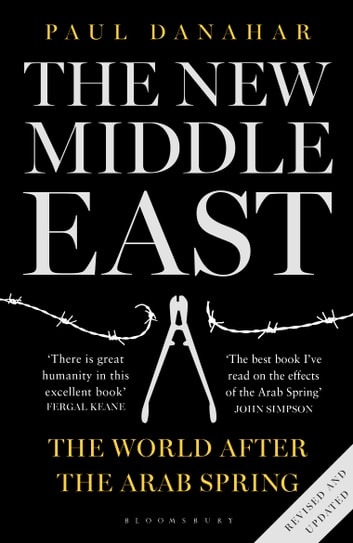The New Middle East : The World After Arab Spring by Paul Danahar An Account of New Cracks within Old Structures

Title – The New Middle East: The World After Arab Spring
Author- Paul Danahar
Published in- 2015
Publisher- Bloomsbury Paperbacks
No of Pages- 496
Price- 1319 Rs. (Amazon)
Oil, dictators, Islam, royal families, bombs, missiles. This is how the Middle East and North Africa (MENA) are usually described. The Arab Spring, the term itself, not only tries to change this description of the region by bringing in the narrative of democracy but also tries to show some amount of positivity in the gloomy theatre of the region.
The New Middle East, a work describing the Arab Spring phenomenon in about eight chapters focusing on the region’s different countries, continues to attempt to show some positivity in the area in its title ‘The New Middle East.’ Its author Paul Danahar is a journalist specialising in Middle East affairs. He worked as BBC’s Middle East Bureau Chief during 2010-13 when the Arab Spring unfolded across the region. This book gives tries to give both a historical perspective on the uprisings in countries like Tunisia, Egypt, Iraq, and Libya, etc, and also a first-hand account by a seasoned journalist of the events that shaped the Arab Spring.
In the Introductory chapter itself, Paul Danahar gives some insightful analysis highlighting the difference between the old and the new Middle East. The New Middle East is marked by the internet and media agencies like Al Jazeera which helped the revolution in Tunisia with its traditional elements of oil, Islam, and dictators and monarch holding their sway. (55) Danahar makes an important distinction that though protests in support of the political reforms took place under Monarchies like Jordan, they were never successful in uprooting those monarchies. In contrast, dictatorial regimes under military rulers in Egypt, Tunisia, and Iraq were uprooted by rebellions. (p.42)
Another important aspect reflected in Chapters on Egypt, Israel, and Libya is that the revolutions during Arab Spring are located in the historical context. The author underlines the role of various wars such as the Suez Canal War in 1956 responsible for the popularity of Arab Nationalism, and the 1967 war as a cause of the decline of Gamal Abdul Nasser. (p.72) Another aspect of this historical analysis is the tracing of the historical trajectory of the Muslim Brotherhood and related Islamic ideals such as Pan-Islamism. Danahar claims that though the ideas of Sayeed Qutb and Hasan Al Banna didn’t change the world much, what people who listened to them did certainly brought a seachange in the politics of the region and the world. (p.88)
The anecdotal style of Paul Danahar’s writing makes sure that the reader engages with a book with its heart and soul. For example, the assassination attempts of the leaders like Gamal Abdul Nasser, and Anwar Sadat have been expressed in a very dramatic style. (p.124) Similarly, personalised interviews and interactions with the stakeholders and actors in the region make the book a more authentic account of what exactly happened during the Arab Spring. Interacting with the families of the victims of Israel’s attacks on Palestine and then analysing the Palestine issue not only gives the problem the kind of attention it requires but also provides human security angle to the problem.
This aspect is often ignored in the mainstream Realist dominated International Relations where war is treated as normal. This kind of account in the book makes the reader aware of the gravity and intensity of the conflict in the region where people live in ‘perpetual fear for their lives. To use Hobbes here, the region thus becomes a perfect example of anarchy where life is ‘nasty, poor, brutish and short.’ Danahar makes it a point that what kind of psychological impact the war will have on the people’s minds who see rockets in the sky every day instead of kites and balloons. (p.127)
However, the book falls short of the rigour required to analyse a phenomenon as complex as the Arab Spring. Though it takes note of actors involved in the theatre of Arab Spring, like Qatar funding Libyan Revolutionaries, it doesn’t really connect the thread between the events in different countries. It provides a microscopic account of Libya, Palestine, Israel, Syria, Iraq, etc. Despite this, Danahar falls short of building a comprehensive block as ‘Arab Spring’ supported by these examples. If looked at from a theoretical perspective in International Relations, Arab Spring is often associated with a constructivist framework as it tries to talk about democratic upsurges through international civil society in the Arab world.
Danahar could have analysed the broad logic behind the Arab Spring process separately and more specifically. For example, whether the Arab Spring helped to bring democracy to the region or not, whether the Arab Spring did force monarchies like Saudi Arabia to push for reforms etc. He could have weaved a beautiful Arab carpet analysing different countries which could have designs of Arab Spring distinguished from each other.
Though he provides details of each design, the carpet in the background is too much scattered, taking away the comfort of seeing the designs of each country. The New Middle East thus is a good analysis to understand new cracks and gaps in those designs, but it lacks the background of old structures like Monarchy, Autocracy, and Religious Fundamentalism which continue to occupy huge space on the Arab Carpet.

MA International Studies |JNU’23 | IR| Public Policy| NET-JRF
About the Author- Currently working as a Guest Faculty for International Relations in Sripati Shastri Research Institute for Social Sciences, Pune
